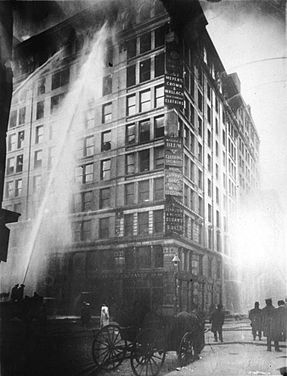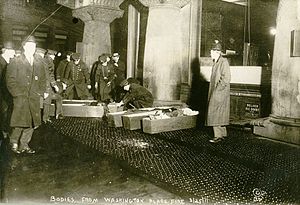The Triangle Shirtwaist Factory fire in Manhattan, New York on March 25, 1911 was one of the deadliest industrial disasters in the history of the city, and resulted in the fourth highest loss of life from an industrial accident in U.S. history. It was also one of the deadliest disasters that occurred in New York City until the destruction of the World Trade Center 90 years later. The fire caused the deaths of 146 garment workers – 123 women and 23 men – who died from the fire, smoke inhalation, or falling or jumping to their deaths. Most of the victims were recent Jewish and Italian immigrant women aged sixteen to twenty-three; of the victims whose ages are known, the oldest victim was Providenza Panno at 43, and the youngest were 14 year olds Kate Leone and “Sara” Rosaria Maltese.
Because the owners had locked the doors to the stairwells and exits – a common practice at the time to prevent pilferage and unauthorized breaks – many of the workers who could not escape the burning building jumped from the eighth, ninth, and tenth floors to the streets below. The fire led to legislation requiring improved factory safety standards and helped spur the growth of the International Ladies’ Garment Workers’ Union, which fought for better working conditions for sweatshop workers.
The factory was located in the Asch Building, at 23-29 Washington Place in the Greenwich VIllage neighborhood of Manhattan, now known as the Brown Building and part of New York University. The building has been designated a National Historic Landmark and a New York City landmark.
Although early references of the death roll ranged from 141 to 148, almost all modern references afree that 146 people died as a result of the fire: 123 women and 23 men. Most victums died of burns, asphyixation, blunt impact injuries, or a combination of the three.
The first person to jump was a man, and another man was seen kissing a young woman at the window before they both jumped to their deaths.
Bodies of the victims were taken to Charities Pier (also called Misery Lane), located 26th street and the East River, for identification by friends and relatives. Victims were interred in sixteen different cemeteries. Twenty-two victims of the fire were buried by the Hebrew Free Burial Association in a special section at Mount Rickmont Cemetery. In some instances, their tombstones refer to the fire. Six victims remained unidentified until 2011. The six victims who remained unidentified were buring together in the Cemetery of the Evergreens in Brooklyn. Orifianally interred elsewhere on the grounds, their remains now lie beneath a monument to the tragedy, a large marbel slab featuring a kneeling woman. The six unknown victims were finally indentified in February 211 and a grave marker placed in their memory.
http://www.csun.edu/~ghy7463/mw2.html
The Tringle Shirtwaist Factory fire was one like the World Trade Center buildings in New York as well, do you recall the day of 9/11? What was going through your head as you watched it on TV? How old were you? Do you think that terrible disasters change the way Americans see the world? After both of these disasters the United States passed new laws.
Related articles







 Triangle Shirtwaist Fire Remembered
Triangle Shirtwaist Fire Remembered
Cowboy94 • May 20, 2014 at 12:12 pm
I do remember the day of 9/11. i was around 7 years old when it happened so i didn’t understand what was going on, but i remember the horror in my family’s faces when they saw it in the news.